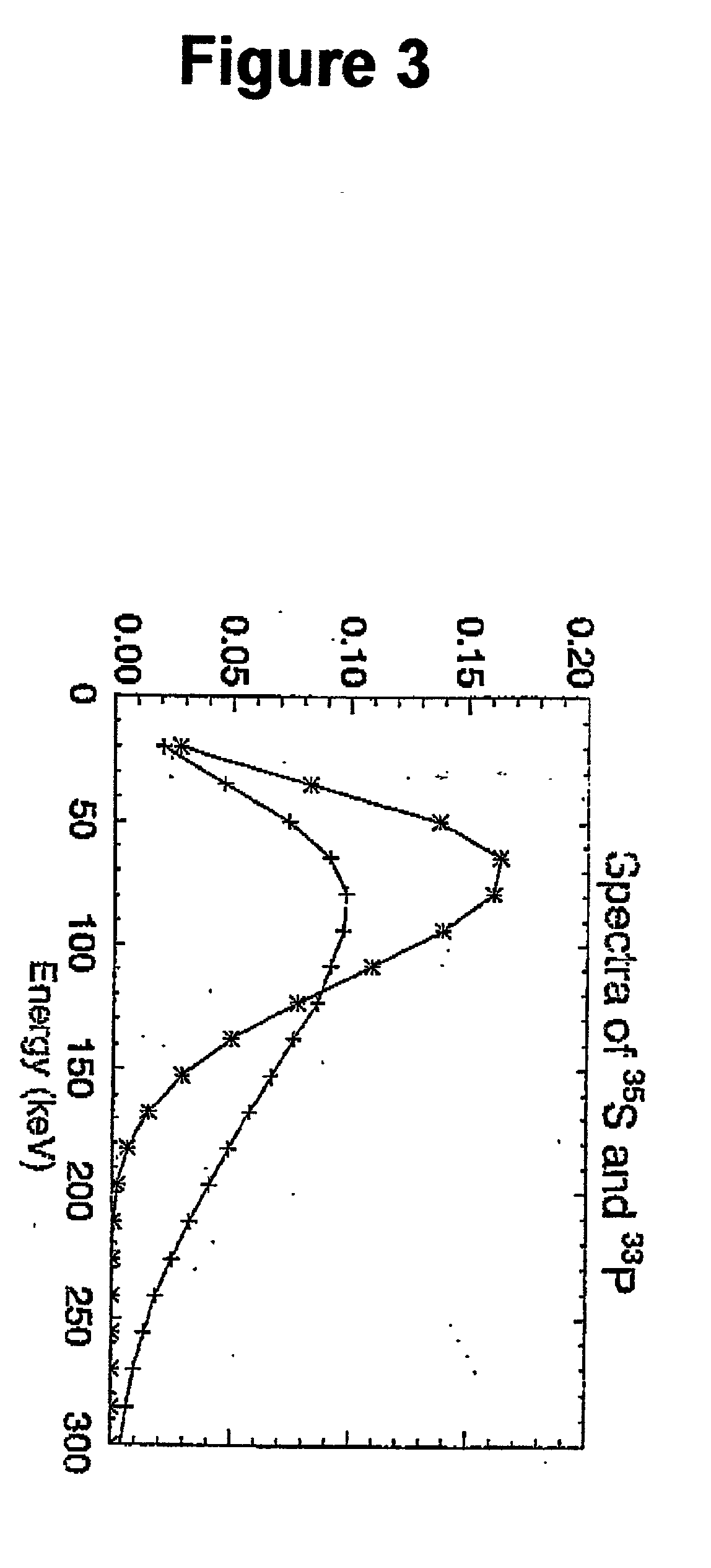Method and apparatus for simultaneous quantification of different radionuclides in a large number of regions on the surface of a biological microarray or similar test objects
a biological microarray and simultaneous quantification technology, applied in material analysis using wave/particle radiation, x/gamma/cosmic radiation measurement, instruments, etc., can solve the problems of limited dynamic range, high amount of material excluded from the use of standard technology, and degree of bias of starting material
- Summary
- Abstract
- Description
- Claims
- Application Information
AI Technical Summary
Benefits of technology
Problems solved by technology
Method used
Image
Examples
example 2
[0073] In order to verify the applicability of the method and apparatus according to the invention for microarray applications, an experiment using two cell line RNAs in reduced amounts were performed. Otherwise standard microarray procedures were employed. By using RNA from two different cell lines, OHS osteosarcoma cell line and MCF-7 breast cancer cell line, a demonstration of a successful separation of the nuclides are performed, and given as a fluorophore plot in form of an overlay pseudo-colour image of the two isotopes in FIG. 5. The figure demonstrates clearly that the method and apparatus according to the invention achieves the dynamic variation of signals that may be expected from similar experiments using fluorophores, but with significantly lower starting RNA-material.
[0074] As mentioned, radioactively labelled biological substances are easily incorporated into living cells as opposed to most fluorescent substances. This may be done by adding medium substituents, such as...
example 3
[0075] The amount of any protein in a cell is partly regulated by the stability of it's corresponding RNA. This is generally considered to be related to the size of the poly-A tail, and partly other sequence-specific factors. To date, examination of individual mRNA species have been the method of choice. By the incorporation of two radioactive labels, it becomes possible to monitor all mRNA species in a population by comparison with a standard. This permits a genome wide scanning of RNA half life, when combined with DNA microarrays.
[0076] Instead of using cDNA with radioactivity in a cell free system enzymatically, a35S-UTP and a33P-UTP are added to the culture medium of parallel cell cultures in appropriate concentrations at time 0. Then the cells are allowed to grow until time 1, when the radioactive nucleotides are sufficiently incorporated to allow detection of RNA produced in the cells from time 0. At time 1, one parallel is treated chemically to block RNA synthesis. At time 2,...
example 4
[0078] In the emerging field of proteomics, similar methods to the one given in example 3 may be applied when using amino acid tags. For instance, the monitoring of various protein degrees of phosphorylation, a major regulatory phenomenon of all cells, may be performed by incorporating radioactivity labelled tags that are added to the medium. By printing antibody arrays, the incorporation of phosphor tags in a number of different proteins may be monitored simultaneously.
[0079] Although the invention has been described as a case of examples of comparison tests of two DNA / RNA-substances tagged with a distinctive S-emitting radionuclide each, it should be emphasised that the method and apparatus according to the invention is a general approach for determining the amounts of radioactivity tagged biological molecules that are adsorbed onto a biological microarray. This applies for all types of radioactivity including .alpha., .beta., .gamma., and positron radiation and all radioactive nu...
PUM
| Property | Measurement | Unit |
|---|---|---|
| diameters | aaaaa | aaaaa |
| diameters | aaaaa | aaaaa |
| radioactivity | aaaaa | aaaaa |
Abstract
Description
Claims
Application Information
 Login to View More
Login to View More - R&D
- Intellectual Property
- Life Sciences
- Materials
- Tech Scout
- Unparalleled Data Quality
- Higher Quality Content
- 60% Fewer Hallucinations
Browse by: Latest US Patents, China's latest patents, Technical Efficacy Thesaurus, Application Domain, Technology Topic, Popular Technical Reports.
© 2025 PatSnap. All rights reserved.Legal|Privacy policy|Modern Slavery Act Transparency Statement|Sitemap|About US| Contact US: help@patsnap.com



